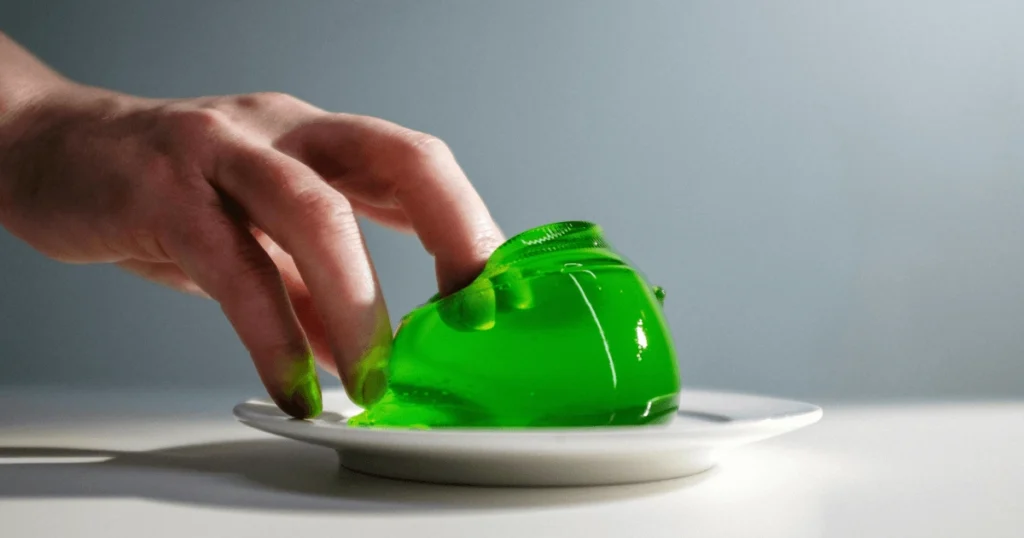Can Dogs Eat Jello? 5 Shocking Facts Every Owner Must Know
We all like sharing goodies with our dogs—those puppy-dog eyes are difficult to ignore! But when it comes to human treats like jello, it’s important to ask: Can dogs eat jello? While this wobbly dessert might seem harmless, the answer isn’t as simple as you’d think. Jello contains ingredients that could be dangerous for your furry friend, and even small amounts might lead to big problems. In this post, we’ll uncover 5 shocking facts about dogs and jello, share safe alternatives, and answer your top questions. Let’s keep your pup safe and happy!
Table of Contents
What’s in Jello? Breaking Down the Ingredients
Before we answer the question, “Can dogs eat jello?” let’s look at what’s in it. Regular jello contains gelatin, sugar, artificial flavors, and food coloring. Sugar-free versions frequently replace sugar with artificial sweeteners like xylitol, which is extremely harmful to dogs. Plain gelatin, on the other hand, is pure protein obtained from animal collagen, with no additional sugars or tastes.
Here’s why jello’s ingredients matter for dogs:
- Sugar: Consuming too much sugar can contribute to obesity, diabetes, and dental problems.
- Xylitol: Even little amounts of this sugar substitute can induce liver failure or death in dogs.
- Artificial dyes: Colors such as Red 40 or Blue 1 may cause allergies or gastrointestinal discomfort in your dog.
Key takeaway: Plain gelatin is safe for dogs, but jello’s added ingredients make it risky.
5 Shocking Facts Every Dog Owner Must Know
Fact 1: Sugar-Free Jello Can Be Deadly
If you’re wondering, “Can dogs have sugar-free jello?” the answer is a firm NO. Many sugar-free jello products contain xylitol, a sweetener that’s safe for humans but deadly for dogs. Xylitol causes a rapid insulin spike in dogs, leading to hypoglycemia (low blood sugar), seizures, or liver failure. According to veterinarians, even one piece of sugar-free jello could be fatal for a small dog. Always check labels for xylitol—it is frequently found in:
- Sugar-free gum
- Peanut butter
- Diet snacks
Fact 2: Plain Gelatin vs. Jello – What’s Safe?
So, can dogs eat gelatin? The good news is that plain, unflavored gelatin is safe for dogs in tiny quantities. It’s a natural protein source that can also benefit joint health. However, jello is not the same as regular gelatin. Jello’s additional sugars, artificial flavors, and colors transform a healthy snack into a dangerous one.
Pro tip: Look for gelatin branded as “unsweetened” or “unflavored” (such as Knox Original). Avoid anything with added sugars or artificial additives.
Fact 3: The Best Gelatin for Dogs
If you wish to treat your dog with gelatin, stick with the best gelatin for dogs:
- Knox Unflavored Gelatin: No additives or sweeteners.
- Great Lakes Gelatin Collagen Hydrolysate: Easily digestible and great for joints.
Combine basic gelatin with low-sodium chicken broth or pumpkin puree to make a delightful, dog-safe snack. Never use flavored jello mixes since they contain dangerous ingredients.
Fact 4: Choking and Digestive Risks
The jiggly texture of ello may appear appealing, but it can provide a choking hazard, particularly for tiny dogs. The slick consistency might become caught in their throat, causing fear or breathing problems. Artificial colors in jello (such as Red 40) may also cause:
- Vomiting
- Diarrhea
- Allergic symptoms include itching skin and paw licking.
Did you know? Dogs can’t absorb artificial colors as well as people, so even a tiny mouthful might upset their stomach.
Fact 5: Hidden Toxic Flavors
Some jello flavors are extra dangerous for dogs. For example:
- Chocolate jello: Contains theobromine, which is toxic to dogs.
- Coffee-flavored jello: Includes caffeine, which can cause heart issues.
- Alcohol-infused jello: Even a little alcohol can poison your pup.
Always keep these flavors far away from your dog!
Safe Alternatives to Jello for Dogs

DIY Dog-Friendly Gelatin Recipes
Why risk store-bought jello when you can make a safe, healthy treat at home? Try this easy recipe:
Dog-Safe Pumpkin Gelatin Squares
- 1 packet unflavored gelatin
- 1 cup low-sodium chicken or bone broth
- 2 tablespoons pure pumpkin puree (not pie filling)
Steps:
- Heat the broth until warm (not boiling).
- Whisk in gelatin until dissolved.
- Stir in pumpkin puree.
- Pour into silicone molds and chill for 2 hours.
These wobbling treats will delight your dog, and you will be relieved that they are safe!
Store-Bought Treats to Try
If DIY isn’t your style, opt for vet-approved snacks:
- Zesty Paws Mobility Bites: Contains gelatin for joint support.
- Blue Buffalo Health Bars: Made with natural ingredients.
- Greenies Dental Chews: Promotes clean teeth and fresh breath.
What to Do If Your Dog Eats Jello
Accidents happen! Here’s what to do if your dog sneaks a bite of jello:
- Check the ingredients: If it’s sugar-free (contains xylitol), call your vet immediately.
- Monitor symptoms: Watch for vomiting, drooling, lethargy, or seizures.
- Hydrate: Offer water to help flush their system.
- Call animal poison control: In the U.S., dial (888) 426-4435 for 24/7 help.
Note: Xylitol poisoning requires urgent care—don’t wait for symptoms to worsen!
FAQs About Dogs and Jello
Q: Can dogs eat gelatin?
A: Yes! Plain, unsweetened gelatin is harmless and can help your dog’s joints. Avoid flavored and sweetened variations.
Q: Can dogs have sugar-free jello?
A: Never. Sugar-free jello often contains xylitol, which is deadly for dogs.
Q: What’s the best gelatin for dogs?
A: Unflavored, additive-free brands like Knox or Great Lakes Gelatin.
Q: How much gelatin can I give my dog?
A: Begin with a teaspoon for smaller dogs and a tablespoon for larger types. Too much might result in constipation.
Final Tips for Safe Snacking
- Read the labels carefully: Avoid using xylitol, artificial colors, and chocolate.
- Moderation is key: Even safe treats like plain gelatin shouldn’t replace balanced meals.
- Ask your vet: When in doubt, get professional advice tailored to your dog’s health.
Fun fact: Plain gelatin can help dogs with arthritis! Its collagen supports joint health and mobility.

